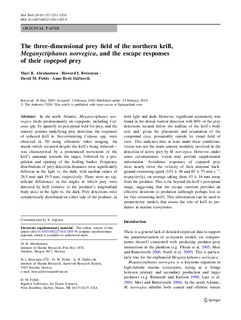| dc.description.abstract | In the north Atlantic, Meganyctiphanes norvegica feeds predominantly on copepods, including Calanus spp. To quantify its perceptual field for prey, and the sensory systems underlying prey detection, the responses of tethered krill to free-swimming Calanus spp. were observed in 3D using silhouette video imaging. An attack–which occurred despite the krill’s being tethered—was characterized by a pronounced movement of the krill’s antennae towards the target, followed by a propulsion and opening of the feeding basket. Frequency distributions of prey detection distances were significantly different in the light vs. the dark, with median values of 26.5 mm and 19.5 mm, respectively. There were no significant differences in the angles at which prey were detected by krill (relative to the predator’s longitudinal body axis) in the light vs. the dark. Prey detections were symmetrically distributed on either side of the predator, in both light and dark. However, significant asymmetry was found in the dorsal–ventral direction with 80% of the prey detections located below the midline of the krill’s body axis and, given the placement and orientation of the compound eyes, presumably outside its visual field of view. This indicates that, at least under these conditions, vision was not the main sensory modality involved in the detection of active prey by M. norvegica. However, under some circumstances, vision may provide supplemental information. Avoidance responses of copepod prey were nearly twice the velocity of their nominal background swimming speed (153 ± 48 and 85 ± 75 mm s−1, respectively), on average taking them 43 ± 16 mm away from the predator. This is far beyond the krill’s perceptual range, suggesting that the escape reaction provides an effective deterrent to predation (although perhaps less so for free-swimming krill). This information can be used to parameterize models that assess the role of krill as predators in marine ecosystems. | en_US |
